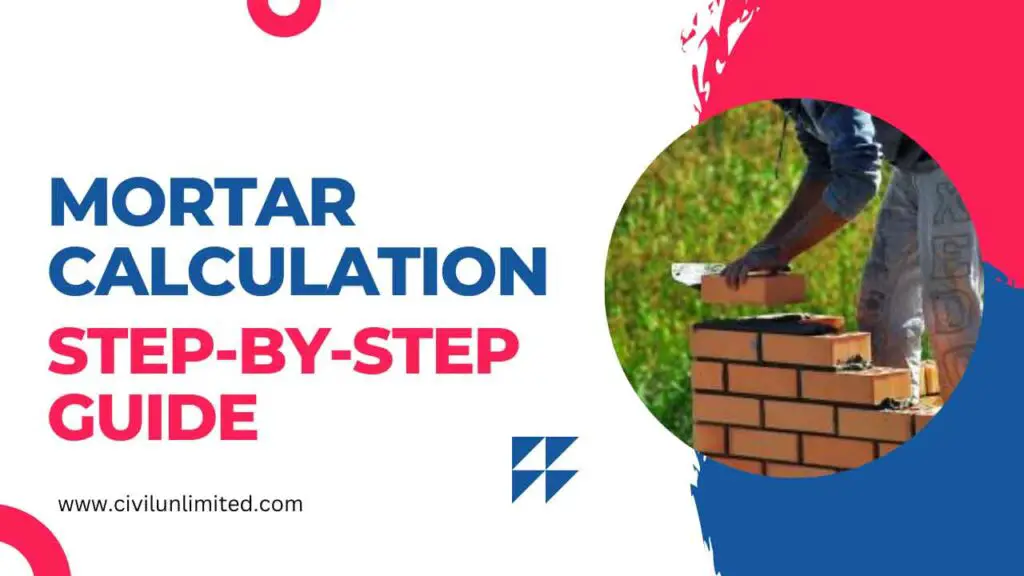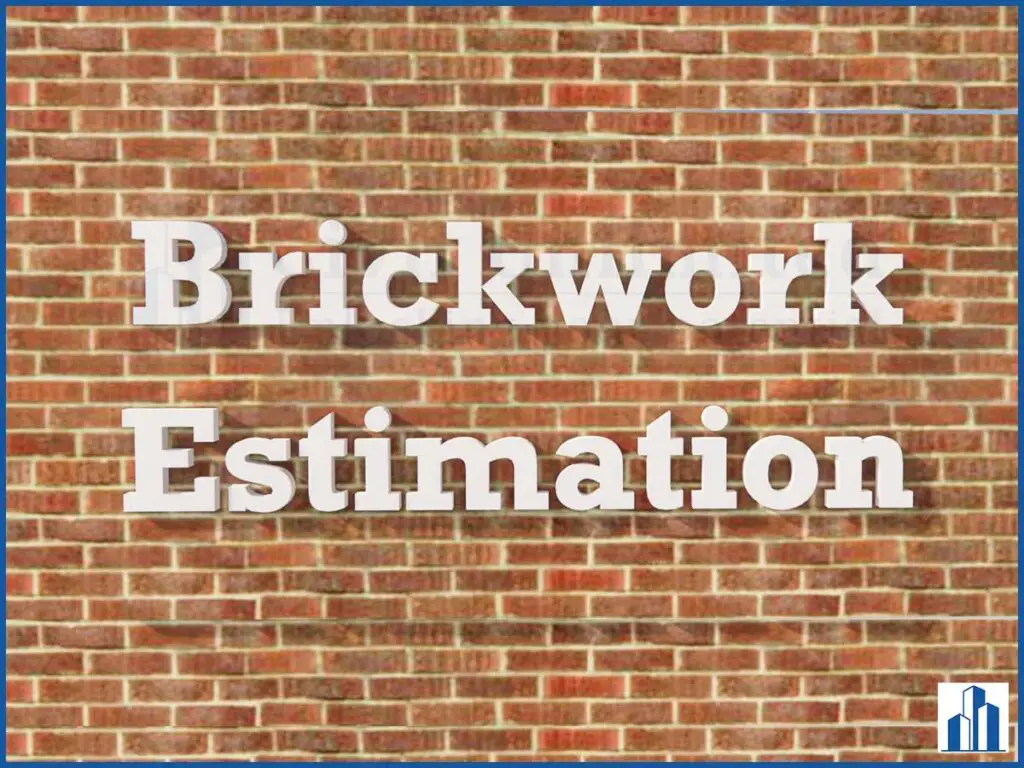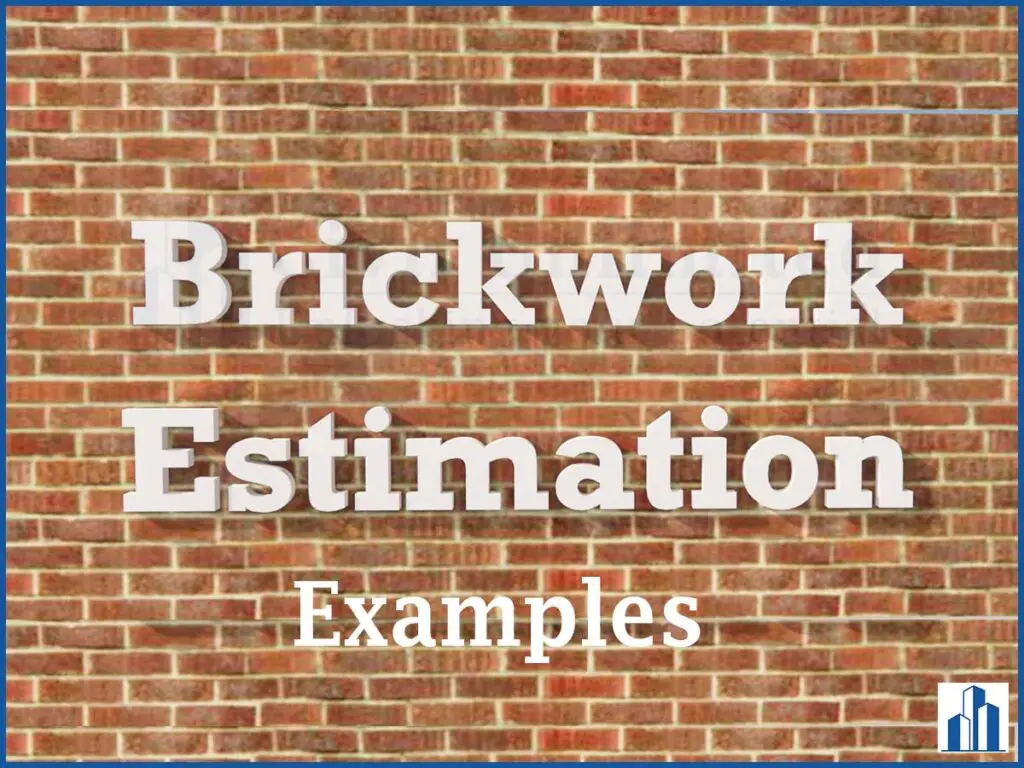In this article, we are going to learn,
- How to calculate the required volume of cement mortar and
- How to estimate the quantity of cement & sand required for that cement mortar.
Step by step Calculation
Step 1: Determine the size of the brick and mortar thickness
Let’s say,
Standard dimension of the brick = 19 cm x 9 cm x 9 cm.
Standard thickness of the mortar = 10 mm (1cm).
Step 2: Calculate the number of bricks required for the volume of 1 metre cube (1m3)
Nominal size of a brick (Standard size of a brick + Cement mortar thickness) = 20 cm x 10 cm x 10 cm.
Number of bricks required = Total volume of a brick wall / Volume of nominal size of a brick
Number of bricks required = 1m3 / (0.20 x 0.10 x 0.10)m3 = 500 bricks. So, 1m3 of brickwork requires 500 bricks.
Why do we use the Nominal size of brick here?
Because in the actual brick wall, both cement mortar and bricks exist. If we calculate the number of bricks using the original dimension of the brick, then we estimate the number of bricks by considering that the whole volume of the brick wall contains only bricks, which is absolutely wrong. That’s why here we use the nominal size of the brick.
Step 3: Calculate the volume of cement mortar in a brick wall
Mortar volume = Total volume of the wall – (Number of bricks x Volume of one brick)
Volume of one brick = 0.19 m x 0.09 m x 0.09 m = 0.0015 m3.
Mortar volume = 1m3 – (500 x 0.0015m3) = 0.23 m3.
Remember, this is the wet volume of the cement mortar. But we need to measure the materials in their dry state. So, to convert it to dry volume, multiply it by 1.3.
Dry volume of cement mortar = 0.23 x 1.3 = 0.30 m3.
Hence, 1m3 of brickwork requires 0.30 m3 volume of mortar.
Step 4: Calculate the quantity of cement & sand
Let’s say, we adopt a mortar ratio of 1:6 (1 part cement and 6 part sand).
In this cement mortar mix ratio,
- Cement proportion = 1
- Sand proportion = 6
- Sum of proportion = 7
Qty of cement required = Dry volume of cement mortar x (Cement proportion/Sum of proportion)
Qty of cement required = 0.3 x (1/7) = 0.0429 m3
To convert m3 into kg, multiply it by the density of cement which is 1440 kg/m3.
Qty of cement required = 0.0429 m3 x 1440 kg/m3 = 61.71 kg.
No. of cement bags required = Qty of cement in kg / Weight of one cement bag in kg (50kg).
No. of cement bags required = 61.71 / 50 = 1.23 bags.
Qty of Sand required = Dry volume of cement mortar x (sand proportion/Sum of proportion)
Qty of Sand required = 0.3 x (6/7) = 0.257 m3.
Note:
For sand, the unit of purchase can vary from place to place.
For example, in India, the sand is purchased as units, where 1 unit means 100 cft (cubic feet). In that case, the above-arrived sand quantity can be converted into cft by multiplying with 35.31.
Qty of sand = 0.257 x 35.31 = 9.07 cft (about 1/10th of a unit of sand).
Free Excel sheet
If you need to calculate for a larger volume or different dimensions, manual calculations can become more tedious and challenging.
In such cases, you can simplify the process by downloading the free Excel sheet linked below and enter your values to obtain instant results.

If you see these calculations for the first time, you may feel a little overwhelmed. But don’t worry, we got you! We provide different examples below so that you can easily understand the concepts.
Examples
1) Calculate the qty of cement and sand required for a brick masonry of volume 10m3. Consider the brick size as 19x9x9 cm, the mortar thickness as 10mm, and the cement mortar mix ratio as 1:6.
Dimension of the brick = 19 cm x 9 cm x 9 cm.
Volume of the brick = 0.19m x 0.09m x 0.09m = 0.0015m3.
Thickness of the mortar = 10 mm (1cm).
Nominal size of a brick = 20 cm x 10 cm x 10 cm.
Number of bricks required = Total volume of a brick wall / Volume of nominal size of a brick
Number of bricks required = 10 m3 / (0.20 x 0.10 x 0.10) m3 = 5000 bricks.
Mortar volume = Total volume of the wall – (Number of bricks x Volume of one brick)
Wet Mortar volume = 10 m3 – ( 5000 x 0.0015 m3) = 2.30m3.
Dry volume of cement mortar = 2.30 x 1.3 = 3m3.
Qty of cement required = Dry volume of cement mortar x (Cement proportion/Sum of proportion)
Qty of cement required = 3 x (1/7) = 0.4286 m3 x 1440 kg/m3 = 618 kg.
No of cement bags = 618/50 = 12.36 bags.
Qty of Sand required = Dry volume of cement mortar x (sand proportion/Sum of proportion)
Qty of Sand required = 3 x (6/7) = 2.57 m3.
Observation:
If the brick size and mortar ratio are the same, then we can easily find out the materials required for any volume, just by multiplying it with the materials which we arrived for 1m3.
However, the size of the brick, mortar thickness, and mortar ratio can vary in different scenarios, that’s why it is essential to learn the correct methodology so that we can do calculations for any given parameter.
Let’s see another example but with a different brick size and mortar mix ratio.
2) Calculate the qty of cement and sand required for a brick masonry of length 15 feet, height 10 feet, and 9 inches width. Consider the brick size as 23 x 12 x 7cm, the mortar thickness as 10mm, and the cement mortar mix ratio as 1:5.
Volume of brick wall = 15 ft x 10 ft x (9/12)ft = 112.5 cft = 112.5/35.31 = 3.18m3.
Volume of one brick = 0.23m x 0.12m x 0.07m = 0.001932 m3.
Nominal size of a brick = 24cm x 13cm x 8cm = 0.0025 m3.
Number of bricks required = 3.18 m3 / 0.0025 m3 = 1272 bricks.
Wet Mortar volume = 3.18 m3 – ( 1272 x 0.001932 m3) = 0.72 m3.
Dry volume of cement mortar = 0.72 x 1.3 = 0.94 m3.
Qty of cement required = Dry volume of cement mortar x (Cement proportion/Sum of proportion)
Qty of cement required = 0.94 x (1/6) = 0.1567 m3 x 1440 kg/m3 = 226 kg.
No of cement bags = 226/50 = 4.52 bags.
Qty of Sand required = Dry volume of cement mortar x (sand proportion/Sum of proportion)
Qty of Sand required = 0.94 x (5/6) = 0.78 m3.
You can cross-check these results by putting the same values in the given Excel sheet.
Hope you understand everything you need to know about the mortar calculation in brickwork. If you find this article helpful, let us know in the comment section.
Read more:
How to check the quality of cement at the construction site?
How to calculate the materials required for the concrete column in 4 simple steps?




Thanks you very much sir
Very helpful. Thank xou